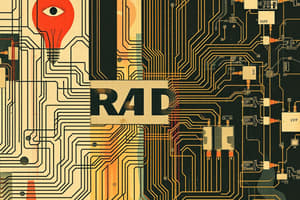Podcast
Questions and Answers
قم بمطابقة التالي: ما هي الفروقات الرئيسية بين الدوائر التسلسلية والدوائر المتوازية؟
قم بمطابقة التالي: ما هي الفروقات الرئيسية بين الدوائر التسلسلية والدوائر المتوازية؟
تسلسلية: يجب على الإشارة المرور عبر كل مكون بترتيب محدد = متوازية: تمر الإشارة عبر مسارات متعددة في نفس الوقت تسلسلية: تستخدم لتغيير سطوع المصباح باستخدام أزرار = متوازية: تستخدم في شبكة توزيع المياه في المدينة تسلسلية: تعتمد على مشاركة الأحمال بين المكونات = متوازية: تعتمد على مرور الإشارة من مكون إلى آخر بشكل تسلسلي تسلسلية: تعطي كفاءة وموثوقية أعلى = متوازية: تعطي انخفاضًا في كفاءة العمل والموثوقية
قم بمطابقة التالي: كيف يُمكن للمعلم أن يشرح كيفية عمل الدوائر المتوازية لطلابه؟
قم بمطابقة التالي: كيف يُمكن للمعلم أن يشرح كيفية عمل الدوائر المتوازية لطلابه؟
باستخدام أمثلة حقيقية مثل شبكة توزيع المياه في المدينة = بإجراء تجارب عملية باستخدام لمبات LED المستقلة باسخدام لامبات LED لتغير سطوعها باستخدام الأزرار = بشرح كيف يجب على الإشارة أن تمر بشكل محدد خلال المكونات باستخدام أنشطة يديوية فقط = بإجراء تجارب فقط دون شرح بشرح أهمية الأسلاك في دوران التيار الكهربائي = بالإشارة إلى أن الأجهزة تشارك في حمولة التيار
قم بمطابقة التالي: كيف يُمكن للطلاب فهم مفهوم الدوائر التسلسلية بشكل أفضل؟
قم بمطابقة التالي: كيف يُمكن للطلاب فهم مفهوم الدوائر التسلسلية بشكل أفضل؟
بفهم كيفية نقل الإشارة من مكون إلى آخر = بالعلاقة بين لامب LED وأزرار التغير بالإجابة على أسئلة نظرية فقط = برؤية كيف يعبر التيار من جهاز إلى آخر بفهم كيف يُطفئ زر واحد جهازًا إذا تعطَّل = برؤية كيف يُصغى سطوع لامب LED باستخدام مجموعات من التحكُّم بالإشارة إلى أهمية استخدام المصابيح LED فقط = برؤية كيف يُغير زر معيَّار سطوع لامب LED
قم بمطابقة التالي: مثال على دائرة متوازية في الحياة اليومية
قم بمطابقة التالي: مثال على دائرة متوازية في الحياة اليومية
قم بمطابقة التالي: كيف يُصغى نظام شبكات المدينة استخدام دائرات متوازية؟
قم بمطابقة التالي: كيف يُصغى نظام شبكات المدينة استخدام دائرات متوازية؟
Flashcards are hidden until you start studying
Study Notes
Sequential and Parallel Circuits Diagnostic Assessment for Sixth Grade
Introduction
Circuit systems are essential components of various devices we use daily, ranging from household appliances to electronic gadgets. Understanding the basics of circuits is crucial for children's education, especially during the formative stages. In elementary schools, sixth graders begin to learn about electric circuits and their associated components. This article provides a comprehensive overview of sequential and parallel circuits, explaining the principles behind each type and offering resources for educators looking to create engaging lessons for sixth-graders.
Sequential Circuits
Sequential circuits refer to a system where elements are arranged in a certain order, with each component carrying out specific functions along the chain. One common analogy for sequential circuits is a conveyor belt in a factory: each employee performs a task before passing the product to the next person, allowing for a smooth workflow. Similarly, in a sequential circuit, the signal moves stepwise through the different components until it reaches the final output.
Example of Sequential Circuit
A simple example of a sequential circuit is a light dimmer switch. When you turn the dial, the signal travels through the dial, relay contacts, and finally reaches the lightbulb. Each component modifies the signal before it passes on to the next, resulting in a lower intensity of light as it progresses.
Teaching Sequential Circuits
To teach sequential circuits to six graders, educators can employ hands-on activities, such as using LED lights and switches. For instance, they could ask students to build a circuit that changes the brightness of a lamp depending on which button is pressed. By understanding the process of moving a signal from one component to another, students can grasp the concept of sequential circuits more effectively.
Parallel Circuits
In parallel circuits, multiple paths allow signals to reach multiple outputs simultaneously. Unlike sequential circuits, where the signal must pass through each component in order, in parallel circuits, components share the load, providing increased efficiency and reliability.
Example of Parallel Circuit
An everyday example of a parallel circuit is a home electrical grid. Transformers receive power from the source and distribute it among many homes through separate wires. If one wire breaks or goes down, the others continue to function, ensuring continuous power supply.
Teaching Parallel Circuits
To introduce parallel circuits to sixth graders, teachers can explain the concept using real-life examples, such as the city's water distribution network. They can then create hands-on experiments, like building a circuit with multiple pathways to light up individual LEDs. Through these exercises, students can learn how parallel circuits operate and appreciate their practical applications.
Conclusion
Understanding circuits is vital for students to grasp the fundamental principles underlying various technologies. Sequential and parallel circuits serve as foundational concepts for further study in electronics and engineering. By incorporating hands-on activities and relatable examples, teachers can help sixth-graders develop a deep appreciation for these concepts and prepare them for future studies in science and technology fields.
Studying That Suits You
Use AI to generate personalized quizzes and flashcards to suit your learning preferences.




